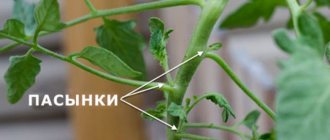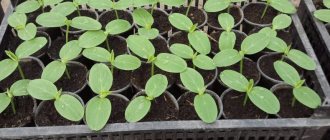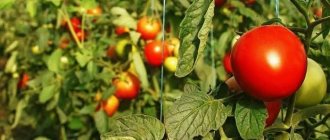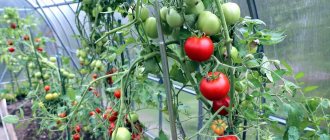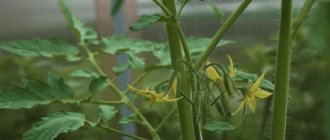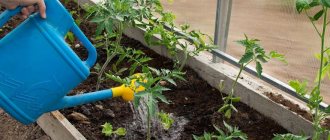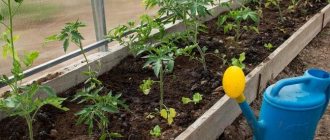Tomatoes are a heat-loving crop. Therefore, they are more often grown in a greenhouse than in open ground. This is a very popular vegetable that grows in almost every summer cottage. Many varieties differ in shape, color, and height of the bush. And also the timing of ripening. However, the care rules for all plants are approximately the same. With rare exceptions due to the specifics of the variety. If you have never grown tomatoes before and you are intimidated by the complexity of the process, then believe me that with some knowledge, growing tomatoes is not at all difficult. The main thing is to first study the agricultural technology of the crop. And also know some subtleties and tricks that will help you avoid unnecessary problems and achieve a good harvest. Like, for example, mulching tomatoes.
Characteristics of tomatoes
Nature intended the tomato to be a perennial plant. But in the garden we grow it as an annual crop, the growth of which, depending on the variety, can range from 20 cm to two meters. In order for tomato bushes to grow well, they first need fertile soil with a neutral acidity level. Quite loose and pre-fertilized with complex mineral fertilizer. Tomatoes need nitrogen, potassium and phosphorus.
When planting, you must follow the rules of crop rotation. And never plant tomatoes where nightshades grew the previous year. Namely: potatoes, peppers or eggplants. The ideal place would be after cucumbers, onions, beets or carrots. And next to the tomatoes you can place celery and garlic. And also spicy herbs. Joint planting with marigolds or calendula will provide additional protection against pests.
The optimal air temperature for tomato growth is +25 degrees, perhaps a little more. At temperatures above +32...+33 degrees in the greenhouse, plant pollen is sterilized. And they stop forming ovaries.
Tomatoes are grown using the seedling method, sowing the seeds a couple of months before the plants are supposed to be transplanted into the ground. When transplanting to a permanent place, you must maintain a distance between plants of at least 40-50 cm. Sometimes more. For example, the Mongolian Dwarf bushes do not grow upward. And in width they reach a meter in diameter.
Tomatoes are transplanted to a permanent location in May or June. As a rule, water once a week. If necessary, remove the stepsons and install supports. They also tie up the bushes so that they do not break under the weight of the fruit. From mid-summer you can start harvesting from early varieties. To make the conditions for tomatoes more comfortable, and at the same time make caring for them a little easier for yourself, there are a number of agricultural techniques. One of them is mulching tomatoes.
How and with what to mulch tomatoes in a polycarbonate greenhouse to get a good harvest
I always encourage you to do everything consciously. This also applies to mulching tomatoes in a greenhouse. To approach the process consciously, let's look at the goals that we set for ourselves when we use mulch; as a rule, it is used for:
- providing favorable conditions for the plant
- for plant nutrition
Providing favorable conditions means:
- weed control
- moisture retention
- temperature maintenance
- degree of impact on plants (acidity...)
It is also worth considering the availability, ease of use of mulch, and the durability of its use. Let's look at how favorable conditions are achieved using mulch.
Weed protection:
It is very difficult for weeds to grow under mulch, as it cuts off sunlight for them. The main requirement in this case for mulch is density and light resistance. The denser the mulch can be packed, the more light it can block. The best mulch in this case will be the foliage of trees and shrubs. Wet foliage cakes very tightly, leaving no chance for weeds to see sunlight. For such mulch, a 3-4 centimeter layer of foliage is sufficient.
You can lay the hay quite densely, but in a layer thicker than the leaves. An even thicker layer is needed for straw. The needles of coniferous trees cut off light very poorly; for normal light retention, a layer of needles up to 20 cm is needed. Compost and humus offer little protection from weeds; on the contrary, they often contain a large number of weed seeds.
Newspapers and cardboard protect from light quite effectively. They are laid tightly and pressed with something. You can press down with hay, straw or weeds, which are recommended to be weeded out first. The small ones can be left, but the large ones are still better to remove first.
Many gardeners believe that mulching tomatoes with straw is preferable to hay, since hay may contain weed seeds. Unfortunately, there are often bales of straw very heavily contaminated with all sorts of herbs; this is probably a question for the straw manufacturer. But it seems to me that this is not worth paying attention to. Sooner or later, weeds will still creep through both hay and straw, they just pull out very easily. Growing up without light, they have a weak, shallow root system and are pulled out very easily, often just with your fingers.
Humus and compost are loose in structure and protect against overheating, but are much worse than straw or hay. And having a dark color, they themselves heat up quickly.
Moisture retention:
One of the most beneficial properties of mulch is moisture retention. It allows you to retain moisture at the roots of tomatoes. If you place mulching materials by rating, it will look like this: foliage, tree bark, hay, straw, humus and compost. The thicker the layer of mulch, the better it retains moisture.
But if you have an additional goal of faster decomposition of the mulch, for watering the greenhouse, more water is required to shed the mulch itself and moisten the soil under it. Different materials react differently to watering. If you water the bed from above, the sawdust will absorb a lot of moisture before it begins to let water through to the ground. The bark of trees, on the contrary, almost does not absorb water, letting all of it pass under itself. If there is a water shortage in your area, I recommend providing irrigation under the mulch layer.
Temperature maintenance:
The temperature regime of the soil in a greenhouse greatly depends on its color. Dark soil warms up noticeably faster than light soil. Therefore, by changing the color of the soil surface we can regulate its temperature. Dark mulch on the surface absorbs heat very quickly, warming the soil in spring and autumn, but in summer, in hot and sunny weather, overheating of the roots is possible.
Light, on the contrary, reflects sunlight, preventing the soil underneath from overheating. This mulch protects the soil and roots of tomatoes from sudden temperature fluctuations, preventing them from getting too hot on a sunny day and cooling down on a cold night. But it is precisely this property of mulch that has a very bad effect on the above-ground part of the tomato when spring return frosts arrive.
Open soil heats up more during the day and releases heat into the air during the day, preventing the foliage from freezing. A layer of mulch is a poor conductor of heat; it prevents the accumulation of heat during the day and its release at night. Therefore, tomatoes should not be mulched with a thick layer in early spring, thereby increasing the risk that the plants will freeze. In the spring, to warm up the soil as quickly as possible, it is better to bare it. But bare soil retains less moisture. In this case, it is better to use dark mulching materials; they will warm the soil faster and retain moisture.
Degree of impact on plants:
Sometimes you can find mulching materials for tomatoes made from pine needles and branches. It’s not so simple here, pine mulch can acidify the soil, if your soil is alkaline, such a choice can be justified, but if the soil is neutral or slightly acidic, then pine needles should not be used at all.
To feed tomatoes:
Almost all gardeners and gardeners are sure that tomatoes need to be fed. And the source of such nutrition is often considered mineral fertilizers or manure, humus, compost. But often mulch is not considered this type of nutrition. There is partly truth in this. Plants do not eat hay or straw. But, during decomposition, organic mulch feeds the soil microcosm - microbes, fungi, worms, insects, which, decomposing the organic matter of the mulch, release organic acids and enzymes, which in turn make soil minerals available for nutrition. And the carbon dioxide released by microbes is used to feed plants.
Without going into the biochemical processes that take place in the soil, organic mulch can provide sufficient and balanced nutrition for your tomatoes. You just need to create the conditions for its decomposition. Just think: in nature there are no heaps of manure and compost, no EO preparations and mineral fertilizers, but, nevertheless, everything grows and develops.
Freshly cut grass and pulled out young weeds, laid in a thin layer, rot very quickly when favorable conditions are created, working no worse than humus and compost, providing tomatoes with balanced nutrition. But laid in a thick layer, they can rot, and from a source of nutrition can turn into a source of poisoning from rotting products.
A thin layer of fresh organic mulch works well for feeding tomatoes. But such mulch requires more frequent application. Hay, especially if it is crushed under optimal conditions, also decomposes quite quickly, providing good nutrition for tomatoes. Depending on the grass, hay is either not added for the entire season, or it is done one more time.
Straw contains fiber that is difficult to decompose; this slows down the decomposition process, resulting in nutrition being supplied more slowly than from hay. But such mulch will last longer; it will not need to be added throughout the entire season. You can somewhat speed up the decomposition of straw by chopping it.
It takes even longer for the foliage to decompose, so even less nutrition will come from the foliage. The foliage becomes of high quality and complete nutrition after it is processed by worms, which can do this quickly. If you don't have a lot of worms in your beds, foliage probably isn't your option.
As you can see, no mulch material can be called ideal for performing all the tasks described. The conclusion suggests itself - mulch for tomatoes should be layered. It is better to make hay or compost as the bottom layer. But the compost will dry out very quickly. No water - no food. This means that the next layer should be a layer that retains moisture - foliage or straw. If you look at nature, you will see that everything is arranged this way - below is last year’s foliage and the remains of plants of varying degrees of decomposition, and on top is more recent litter that retains moisture.
Those. It is possible to create something like an ideal mulch layer for tomatoes, and this is what we should strive for.
Is it possible to mulch tomatoes with sawdust?
I am often asked if sawdust can be used to mulch tomatoes. My opinion on this issue is negative. There are three main reasons for this:
- sawdust can acidify the soil, which is often done
- sawdust causes a high load on soil microbiota in terms of nitrogen
- pine sawdust has resinous secretions
This all applies to fresh sawdust, but if you prepare the sawdust first - it will decompose for at least 6 months, for example, mixed with manure or compost, then it will be possible to use it. It is still better to use sawdust as mulch for acidophilic plants that love acidic soils, and for tomatoes it is better to use other mulching materials.
How to properly mulch tomatoes in a greenhouse
Proper mulching means that the mulch best meets your needs - protects against weeds, retains moisture, and nourishes the tomatoes. If it still looks aesthetically pleasing, that will be absolutely great. Let's talk how to achieve this.
As I already wrote, it is impossible to achieve all goals with one mulching material; for this, the mulch must be layered. The bottommost layer can be placed in the form of a layer of hay or ready-made compost. It will provide plants and soil biota with nutrition. This layer should be covered with a layer of straw on top. The straw will cut off sunlight to prevent weeds from growing, will serve as a thermostat and will not allow moisture to evaporate.
But there is a downside to such a layer cake, a thin layer of compost or hay can quickly decompose, which means you need to add a nutrient layer, and you have straw on top. Removing straw is very inconvenient. In this case, I proceed as follows. I cover all the tomato bushes with straw, and add a feeding layer consisting of compost and freshly cut grass with a narrow strip under the straw in the middle between the tomato bushes.
When I make a green infusion from mowed herbs, I water the bushes with it not at the root, but pour it on a strip of straw, under which there is a feeding layer. Periodically, as the compost or grass decomposes, I add a new layer. Once a week I spray everything with ACH. At the same time, the rest of the straw layer remains untouched.
Another important factor when using mulch. As I wrote above, in the spring it is necessary for the earth to warm up as quickly as possible. This is best achieved with bare soil. Therefore, add mulch to the greenhouse when the soil layer has warmed up. I usually do this at the end of May - beginning of June. Until this time, tomatoes grow in the greenhouse without mulch.
What is tomato mulching?
The first mention of mulching dates back to the 17th century. It was then that the British began to cover the soil so that the strawberries would not get dirty. Later, other beneficial properties of this technique were discovered.
Mulching is covering the soil around plants with some organic or industrial material. This protects the plant roots from the cold. And also from overheating. Inhibits the growth of weeds and prevents excessive evaporation of moisture. And also, with the right material chosen, mulching protects against harmful insects and the development of certain diseases.
When choosing raw materials for mulching, be based on the fact that it should not harm plants. That is, it should not be toxic or greatly affect the composition of the soil during the decomposition process. And also the raw materials must be easily accessible and profitable from an economic point of view. Because we are trying to avoid unnecessary financial investments and labor costs. The benefits of mulching the soil surface are quite great.
In hot weather, the top layer of soil does not dry out. Accordingly, a crust does not form. And also the access of air to the root system does not stop. Weeds grow extremely slowly at first. And then they stop growing altogether. Accordingly, all nutrients go to your crop. Gradually, the lower layer of organic mulch is eaten by earthworms. They process it and enrich the soil with humus, significantly increasing the amount of nutrients.
When watering tomatoes, mulch protects the roots from soil erosion. It also prevents moisture from evaporating too quickly, thus reducing the number of waterings, and at the same time controlling the level of air humidity in the greenhouse. In a closed space with high humidity, an environment is created for the development of rot and fungal diseases. A layer of mulch prevents their spread.
Open and closed ground - features of mulching
The approaches to mulching tomatoes in open and protected ground are somewhat different.
For closed ground in a greenhouse
The eternal problem of closed ground is room ventilation and stagnation of damp air. Black film significantly reduces air humidity because it prevents the evaporation of water from the soil.
It turns out that black film not only saves water, but also prevents fungal diseases. Before laying the film, the bed should be fed with complex fertilizers or sprinkled with compost. It is advisable to organize drip irrigation - greenhouse conditions are more suitable for this than open ground.
Mulching a protected soil bed has a dual function. Greenhouse vegetables are cultivated using intensive technology. The growing season of tomatoes growing in a greenhouse is almost 2 times longer than in the ground. It is not surprising that they require 2 times more nutrition for full fruiting. Therefore, for greenhouse conditions, it is imperative to choose mulching material:
- which either itself quickly decomposes into nutritional components;
- which allows artificial feeding to be carried out in the most convenient way.
Compost and mature humus are the best options for greenhouse tomato crops. It is advisable to apply a layer of at least 5 cm. In the absence of organic matter, use almost any light-proof material.
In the video, the author talks about how he mulches tomato bushes when it is necessary to trim the leaves.
Features of mulching ground tomatoes
In an open-air tomato bed, the growth conditions are far from greenhouse conditions.
They are more susceptible to wind erosion: a combination of water, wind and sunlight turns the topsoil into rocky soil. Plants perceive even a lack of water not as painfully as the appearance of a dense crust that disrupts air exchange processes.
The mulching material must meet these conditions. The same black polyethylene can only be used in combination with a heat-insulating layer of straw or sawdust.
Preference should be given to organic materials - compost, leaves, chopped straw, etc.
The second most important criterion is light resistance. The mulch layer should be at least 5 cm, then weeds will not be able to break through to the light.
Mulching tomatoes: what can be used?
The choice is wide enough so that everyone can choose the most convenient material for mulching. If you prefer organics, you can use straw, pine needles, freshly cut grass, sawdust, and compost. Or you can opt for inorganic materials. And choose between plastic film, geotextiles, cardboard or newspapers. There are also both organic and inorganic materials that are best not used for mulching. No matter what anyone says. Because there will be much more harm than good.
Organic mulch is, of course, more popular. Because in addition to its protective functions, it also acts as a fertilizer, gradually decomposing and nourishing the soil. This makes for much better growth. And also the ripening of tomatoes.
Straw as mulch
In order for the mulch to be beneficial, you will need to lay at least a ten-centimeter layer of straw. After some time it will settle a little. But it will still cope with its functions perfectly. Namely: let air through, retain moisture, insulate heat. The straw also prevents sunlight from reaching the weeds. And that means it doesn’t allow them to grow.
In addition, straw protects tomatoes from rot and anthracosis. Straw is one of those materials that is processed into fertilizer. This means it has a positive effect on the growth and productivity of tomatoes. But there is one important drawback: mice love to live in straw. So you need to regularly inspect and stir it, checking for the presence of pests.
When to perform this procedure?
Mulch, as mentioned above, retains moisture in the soil and does not allow sunlight to reach it. Therefore , it matters whether the greenhouse as a whole is heated or not .
Laying the layer should take place in an unheated greenhouse , where the ground is not artificially heated. This should be done after the frost has passed , and the earth has already warmed up quite deeply.
If the greenhouse is heated , mulching is carried out at any time when the plants are planted.
The installation technology determines the selected coating . Loose mulch is poured between the plants. The layer should be several centimeters. And around the stem you need to leave a small space to freely water the shoots.
Mulching tomatoes with grass
This method is especially convenient for the lucky owners of a lawn mower with a grass catcher. The grass cut in this way does not need to be further chopped. Because she's already chopped up enough. It just needs to be spread out and dried for a few days in the sun. Then, as with straw, spread a good layer of mulch over the surface of the soil.
After a few days the layer will settle, then more should be added. As a result, the mulch layer should always be at least five centimeters. As the lower layer of grass rots and decomposes, important trace elements enter the soil. In particular, nitrogen, which tomatoes love so much in the first half of summer. In addition, grass retains moisture well. Therefore, the volume of weekly watering can be reduced.
Sawdust
Another very popular mulching material. In addition to its useful properties, sawdust also looks very decorative. Therefore, many gardeners prefer them. A layer of at least 15 centimeters must be laid. Because a smaller layer will not be an obstacle to the germination of weeds. Sawdust perfectly controls moisture, absorbing excess and releasing it into the soil as needed. But there is also a significant drawback. Sawdust can pull some of the nutrients out of the soil. And also increase the acidity level of the soil.
To prevent this from happening, the sawdust must first be prepared. You can mix them with some alkaline material. For example, chalk, ash, lime or dolomite flour. Or you can “marinate” them for a month by adding a little urea and water and covering them with plastic wrap. Properly prepared sawdust will not harm the soil or plants.
Organic
For tomatoes, this type of material is more preferable, because it has one significant advantage. Over time, the organic coating begins to turn into a nutrient medium so necessary for tomatoes. Depending on the source materials, the soil can be saturated with various microelements included in the fertilizer. This means that this process can be regulated.
Straw works well for mulch. It protects the plant well from early rot, anthracnose and leaf spot. These are excellent heat insulators that do not, however, interfere with the free circulation of oxygen. The thickness of the layer of such coating should be 10-15 cm
It is important, however, to regularly inspect the straw for pests and rodents.
Mulching with mowed grass in a greenhouse significantly increases the yield of tomatoes. Under the influence of such a coating, the soil is constantly enriched with nitrogen and nutrients. The grass layer should be thick enough
It is important that the grass is young, without seeds. To prevent insect pests from crawling onto the tomatoes, the grass should be dried in the sun.
Mulch made from forest materials is very useful. Needles saturate the soil with beneficial bacteria. Suitable materials include pine sawdust and bark. They are stronger than other plant materials, and therefore more durable. There are a number of rules for using forest material:
- The wood must be well dried;
- The mulch layer must be treated with a 5% urea solution;
- The first layer of sawdust should be covered with chalk or slaked lime. This measure will prevent the soil from oxidizing.
The thickness of the compost layer should be 3 cm. You can mix it with other types of mulch, so it will be more productive.
Mulching tomatoes with compost
This is, from a plant point of view, an ideal mulch. It's easy to prepare. Because on every plot there is a compost heap or hole where gardeners send weeds. As well as waste for rotting and obtaining useful organic fertilizer. It takes at least a year to prepare compost. If it is not completely rotten, then weed seeds and insects may remain inside. Therefore, make sure it is ready before use. It should have a uniform consistency and no odor.
Place 3-4 cm of compost on the soil surface. Periodically you will have to add a new layer. Because earthworms will process it very quickly. Compost both protects and fertilizes tomatoes at the same time. But it's important not to overdo it. Because with a very large supply of nitrogen to the soil, tomatoes will begin to “fatten.” That is, to increase foliage, to grow without forming inflorescences and fruits.
The only drawback of this material is its unaesthetic appearance. But the advantages in this case undoubtedly outweigh. I repeat, the main thing is that the compost is completely ready.
Soil treatment before sowing
If you independently prepare a nutritious soil mixture for seedlings from garden or garden soil, it must be disinfected. It accumulates a large number of eggs and larvae of pests and pathogenic microorganisms. Therefore, it is impossible to grow healthy tomato seedlings without preliminary disinfection.
How to cultivate soil for tomato seedlings:
- Freezing - when the air temperature drops around -15°C, take the soil for sowing seeds outside. Leave it for 48 hours to completely freeze, then bring it back into the room. Due to this, weed seeds and pest larvae will “come to life”. After this, take the soil out into the cold again, repeat the procedure 3-4 times.
- Steaming helps not only to disinfect, but also to evenly moisten the soil. To do this, pour the soil into a colander or fine sieve and hold over a container of boiling water for 15 minutes. Don't forget to mix the soil thoroughly. Once cooled, it can be used for sowing seeds.
- Calcination - pour garden soil into a frying pan or baking sheet in a layer of about 4-6 cm. Spray with a spray bottle and place in an oven preheated to 80°C. After 25-30 minutes, remove and leave to cool.
- Spilling is one of the most popular and common methods. To disinfect the soil, a solution of potassium permanganate is used. For 5 liters of water you will need 1-1.5 g of potassium permanganate.
- Treatment with drugs - instead of a solution of potassium permanganate, you can use industrial disinfectants. These include Hom, Bravo, Quadris.
Soil with sawdust for tomato seedlings helps to obtain lush, healthy and viable seedlings. Wood waste improves the structure of the soil, making it lighter and looser, improving its fertile qualities, air and moisture permeability. You can make such a soil mixture yourself and be confident in its quality and environmental friendliness.
Inorganic mulch
You can also use inorganic materials for mulching, which will last much longer. They can be used for several seasons. Some gardeners do not consider it necessary to spend additional funds on purchasing such materials. However, those who use them are satisfied with the results. Because a greenhouse effect is created, which significantly accelerates the growth of tomatoes.
Mulching tomatoes with film
Of course, we are not talking about transparent film for greenhouses. And about a much denser opaque material. For southern sunny areas, a light-colored film is better suited. For the middle stripe, you can use a dark film. Such covering material will definitely prevent weeds from growing. You just need to correctly spread the film over the surface. And also secure it well around the perimeter. Well, such a shelter is only suitable for not very hot summers. Otherwise, the earth will overheat too much. And also the development of fungal diseases may begin.
Cardboard and newspapers
Such a shelter does not allow air to pass through and does not provide additional nutrition to the soil. So its main functions are insulation and protection from weeds. The soil around the tomato bushes must be loosened. And also carry out additional feeding. Sheets of cardboard must be laid overlapping and fixed. You can make holes in them for air circulation. And paper or newspapers can be pre-shredded. Soak in a nutrient solution and lay in a thick layer, like straw or grass. Be careful - slugs can breed in paper that is too wet.
Useful tips and tricks
In order for mulching to bring maximum benefits to tomato beds, it should be carried out taking into account several useful tips:
- Hay and straw should not be laid out in a layer higher than 8 cm - this will lead to compaction of the soil and the rapid development of rotting of the mulch.
- When using whole sheets of cardboard or paper, you must first make small holes in them to improve the supply of oxygen to the soil.
- Paper and cardboard do not saturate the soil with nutrients, so you can add a layer of fertile organic mulch underneath them.
- The mulch should be laid in such a way that there is a short distance to the stem and lower leaves of the tomato bush.
- Don’t be afraid to use newspapers as mulch - modern printing ink does not contain lead or other hazardous substances. This material is completely safe for grown plants.
Proper mulching of beds in a greenhouse or garden is a simple and effective way to protect tomatoes from fungal diseases and insect pests, feed them with useful mineral elements and protect the root system from adverse weather conditions. Mulching saves the summer resident time on regular watering, loosening and weeding, creating comfortable conditions for active growth and generous fruiting of tomatoes.
Geotextile or non-woven fabric
This is an excellent material for mulching tomatoes. Its only drawback is that it is not the cheapest price. But on the other hand, by purchasing geotextiles, you can use it for several years. So it might be worth the once-in-a-lifetime investment. This is a dense material that is capable of allowing both air and moisture to pass through. And since it is opaque, it also protects against excessive overheating. And also from the cold. Prevents the spread of diseases and harmful insects. In summer you can use it to mulch tomatoes. And in the fall, use the same fabric to insulate shrubs or trees.
What materials should not be used
There are a number of materials that seem suitable for mulching, but are not recommended for use:
- Peat is useful if mixed with soil in certain proportions. But as a mulch, pure peat will greatly increase the acidity level of the soil. Which will have an extremely adverse effect on the growth of tomatoes.
- Manure can also be useful as a fertilizer after it has rotted. But when fresh it is almost guaranteed to burn plant roots.
- Ruberoid - on the one hand, it can be used forever. It will also perfectly prevent the germination of weeds. But this material is usually quite toxic. Especially in hot weather when it gets hot. So it’s better to refuse it too.
Other types of organic materials used for soil protection
Straw is perhaps the most common type of mulch. It can be used in gardens and vegetable gardens. The layer thickness can be 10-15 cm. It can be combined with other types of protective coating. A good result is achieved by mixing straw with rotted manure or compost. When using such material, the soil structure improves and the number of certain pests, such as slugs, decreases.
An excellent option is high-moor peat. Why? There are several reasons for this. Firstly, mulching the soil with peat enriches it with nitrogen, magnesium, phosphorus, potassium and calcium. Secondly, such a covering performs a decorative function - it is used to cover green spaces, beds with strawberries, and flower beds. Thirdly, peat has a beneficial effect not only on the soil itself, but also on the root system of plants. In addition, it is suitable for use in greenhouses and greenhouses.
When creating a protective cover, it is necessary to remember that organic substances should not be damp, much less wet, otherwise such a layer will become moldy. For this purpose, you cannot use grass treated with herbicides and other pesticides.
What time to lay out mulch
If your greenhouse is heated, you can mulch the soil at any time. Regardless of weather conditions. And if there is no heating, then it is better to wait for the soil to completely warm up. And also the absence of night frosts.
When planting tomatoes in open ground, you need to wait until the seedlings are fully adapted. By this time the soil should warm up to a depth of at least 30 cm to a temperature of +14...+16 degrees. After this, you can spread the mulch.
Mulching tomatoes is an excellent agricultural technique that has a positive effect on plant growth. And also on the amount of harvest.
Optimal time
It is important to know not only how and what to mulch tomatoes in a greenhouse, but also when is the best time to do this so as not to harm the seedlings. The time for this process depends entirely on the soil warming up.
- If you have a heated greenhouse, then you can mulch tomatoes at any convenient time, as needed.
- In a greenhouse without artificial heating, it is better to mulch after the soil has warmed up sufficiently (about 15 degrees) and the threat of night frosts has passed.
Despite its ancient origins, the agricultural method of mulching is still popular today. This is the most effective way to increase the yield of greenhouse tomatoes in personal plots. In addition, this method makes caring for tomatoes much easier and saves your time. We wish you good luck in the garden beds!
